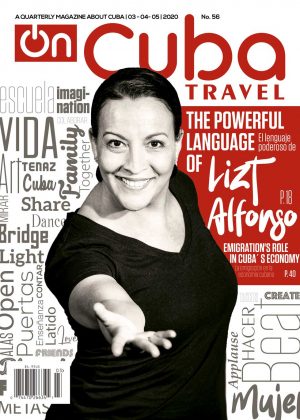A bucket, a reed flute and a guitar missing strings. That was the format of the first group of José Luis Cortés, el Tosco, founder of NG la Banda, an Irakere and Los Van Van veteran, one of the most brilliant and prolific Cuban musicians, who in addition is a showbiz character.
He was born on October 5, 1951 in El Condado, Santa Clara, a barrio “totally artistic from the musical point of view,” he says. “That place was full of rumba, of Santeria drum beats, of the Yoruba religion…a great many things that in the end have to do with popular dance music.” A neighbor, Antonio Ríos, more or less played the guitar, and taught him to sol-fa a bit. “That’s where my link to music began,” that is, his link with what would be everything for him.
The father played the timpani in a circus band. The mother wanted to be a singer but his grandfather “was adamantly against it because of the concepts that existed at that time that if you worked in cabarets you were a prostitute. And you know how the old people used to get before, they were intense,” he says dragging out the final “s”.
In the end his mother sang…at home, while she was doing the dishes, for example. “And she did it quite well. I know all those songs she sang.”
Through one of the “Revolution’s plans from that time” he applied for the fishing and the nation art schools. He filled out the two forms “because what was important was to get out of there. To leave that environment because it was terrible, if I stayed I was going to be a good criminal, a good drunkard, a good tough guy.”
By chance he first got the form for the National Art School. “When I got there I wanted to study violin on and on, because in the barrio there were some TV sets and we used to see that in the bands the violinists had a very different flair.” But he didn’t have the conditions, “and that’s it, they left me with my tail between my legs because I didn’t want to study anything else.”Until
***
Antonio Pacheco was studying the flute at an advanced level and told him: “Hey, go do the test for the flute. You know that the flute is the instrument of the gods.”
“He talked me into it and I accepted. I did the test, and I passed.”
At the beginning he didn’t like too much the instrument that has been his mainstay for 47 years. “Now, from the spiritual as well as material point of view, it is wonderful for me.”
“In the school we used to move a lot in the sphere of popular music, which at the time was taboo in the art schools. They wanted everyone to play Beethoven, Mozart, Haydn, but no one wanted to play Antonio María Romeu’s music, not even Caturla’s! It was ‘out, out, damn spot” with whoever was caught playing that music. You would be reported, your pass would be taken away.”
How did you assimilate the rigor of the academy?
I got to like it. I already saw myself wearing tails, a bow tie, and playing in a Mozart concert. I played him, as well as Haydn, difficult pieces for flute. I just thought of myself only playing in a concert – not a symphony orchestra, I never liked being a music stand kind of person but rather a soloist. Until I had problems and I was kicked out of school. And I had to go out and wear out some shoes.
I had to get out there, I wanted to sing with Santa Clara’s Aliamén band, but then Ritmo Oriental came along and they told me: “We’re going to Havana.” And I came. They had already taken me to the rehearsals of Los Van Van, but my dad didn’t want me to play popular music, he wanted me to be a classical musician. In any case I started playing with Los Van Van…until comrade Compulsory Military Service came along.
After that I went through a stage with Los Van Van, and later Irakere. Afterwards came NG la Banda that is now celebrating 30 years, which despite all the hurdles, the music groups, the besmirching, all those words that are super negative words…watch out: is more valuable because it has known how to maintain itself there.
Now I’m compiling things. The group was born on April 4 not because I wanted it that day, but rather by chance. They told me they would donate the instruments if I played at a party and I played. It wasn’t like “let’s do it because it the youth and pioneers’ day.
I want to organize a party. Open bar for the people. Let’s see if I can get the cash for two cistern trucks of beer and that the people drink them, give away bottles of rum. And perhaps after that I’ll retire

Is the timba in crisis?
You have to explain to children the whys. If you censure children and tell them: “Look here, don’t take that camera, if it breaks and it costs 3,000 dollars,” and you let them touch it and show it to them, it’s not the same as they go and touch it and you tell them: “Hey, don’t touch the camera, damn it!” And they touch it. It’s the same with music. Everyone played reguetón, it was eliminated, they started talking against it.
But there are private bars where the owners play what they want. You also have to visit the bars to know what is happening in music. I bet you won’t hear anything from the Aragón band.
In the Package [a weekly package of music, series, films, documentaries, etc.] and in the bars there’s reguetón 24×7. Now Alexander Abreu has caught on and the people have called him “the oxygen of Cuban music,” playing the same thing, a copy of what NG la Banda has always played.
The genre, the dance, the group that makes video clips came in. Because it’s not the same to hear than to watch. Now everybody wants to live the way the Americans do, all the cars are imitating the cars of the reguetón musicians from Puerto Rico and Dominican Republic. The people, the youth, prefers that. They let go of things and everybody aspires to have what’s good. People used to tell me: “Hey, but you have a Mercedes Benz!” And I used to tell them: “Come on, if Fidel has a Mercedes Benz, why can’t I have one? That must be the best car because if he uses it…. And I bought it with my money. Work, struggle, save money and buy whatever you want.” Anyway, in the end I had to sell it….

What music do you listen to?
I like Brazilian music. It kills me. And I’m especially listening to Ella Fitzgerald, who isn’t Brazilian but sings many things from Brazil. She sang all that samba. Elis Regina, Milton Nascimento, Djavan, and Jobim, the king of Brazilian music, one of the ones who invented the bossa nova. Those are the most beautiful themes in the world.
I listen to that and once in a while to classical music. I love Tchaikovsky, I like Brahms, which people don’t like, but Brahms’ orchestration, watch out! Get into the music. You have to feel the counterpoints he has, the string…he’s the best. Chopin, Schubert, who is another monster. Liszt, another monster. The neo-romanticism, the impressionism…it’s what I most like to listen to. Because as you know the baroques are something else, for the studios.
Why El Tosco?
Because of a pair of boots. When I was in school, during a productive work stint, I overslept and was not present when the work clothes were given out and the only thing there was were one of those ugly hairy Russian boots. They were size 12 and I used the 7.
But I’ve always been a clown, in the sense that nothing daunts me. Clown in the sense that nothing gives me a complex. “That’s what there is?” Well, I put them on. And since I was going to the canteen, which in the school was where the girls and boys engaged in social graces, and in jokes, they named me “the man with the rough [tosco] boots.” It was Calixto Manzaneros, who was studying to be a music arranger.
Of course, in Cuba everything becomes smaller, and I was left with El Tosco. But I have nothing to do with that. My surname is Cortés [courteous]! I’m the antithesis: there’s a long stretch between Tosco and Cortés.
I don’t like rough things, except for boxing which I do like. I’m not into everything else, although I have nothing to do with flowers or birds. There’s a very big confusion with that, because they say that Libras have a lot in common with those things. Just check the famous Libras so you can see none of them have nothing in common with me.
Do you consider yourself the founder of the timba?
Well, I don’t know, let them fight it out. That has been said by Juan Formell, Chucho Valdés…although Chucho says: “He already played timba when he was in Irakere.”
There’s a concept there to discuss it, but I’m not going to argue with the greats. They are the ones who know. El Tosco did do the timba, but the timba was already played by Irakere. Formell said: “He was the one who brought everyone together and did the Cuban timba.” Adalberto [Alvarez] says the same. Everybody says the same. They say it, I don’t say it. What I did was music. Just that.
And I had the opportunity of playing with Irakere and having played with Los Van Van and I say that music is a hybrid. The orange cut in half, grabbed one way or the other, is still an orange.
It is said that “NG la Banda is what made everybody danced to in the 1990s and early 2000.” That’s what the people say, don’t look at me. It’s up to them.

What has the flute represented in these 47 years?
The flute is part of my soul, it is my heart, it is through which I can really express the music I do. I play the piano a bit, a bit of bass, but my thing is really the flute and it makes me transmit what I have here inside of me. The flute without me…rather, I am nothing without the flute.
How many do you have?
Thirteen. None of them are my favorite, the favorite one was stolen; someone changed it for a porn movie. The flute cost 10,000 dollars, the film 15 euros. During a tour an Italian couldn’t find his film, and it seems that he saw the flute and said: “I’ll throw this away.” It was completely made of silver. It probably still has a pedigree, if someone finds it they have to give it back to me. Murakami bought it for me. He said I had to have the best flute in the world and he bought it for me.
What are your routines?
Wow, I can’t explain it to you…. The night. If you don’t live at night you miss the truth. And you miss the glamour, showbiz, the things that are important in this environment to be able to live.
I go out every night, whether I have work or not





